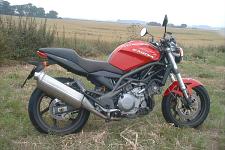2001 Cagiva Raptor - Motorcycle.com
Dank Cyber-Bistro, August 11, 2000
There was a time when the Japanese could make a powerful and reliable engine but struggled to build a good handling chassis to compliment it.
In those days only the Italians or the British could make a bike that handled properly. However, they found it almost impossible to make an engine that could match the best coming from Japan. Today, only a complete bigot would claim that the Japanese haven't got the handling game down to a pretty fine art. So where does that leave the Europeans? According to the Italians it leaves them taking care of style.
To an Italian, style is everything. Form and function follow style, they do not preceed it as in the Japanese culture. When Cagiva decided to launch a new superbike -- the MV Augusta F4 -- they spent a small fortune developing their own motor. They wrapped it in exquisitely styled bodywork and ensured that all of this was complimented with class-leading handling. The problem was that it lead to a sticker price that would have the average motorcyclist leaving the showroom -- pronto. What Cagiva needed was something that was equally stylish but with a more down-to-earth price tag. Their solution was the Raptor (and the V-Raptor). Both have stunning looks but lack a price tag that leaves you equally stunned. How did they do it? Simple, they went back to a tried and tested formula; they let someone else build the motors.
The 90 degree V-Twin, liquid-cooled engine was an inspired choice since Cagiva wanted to out-do Ducati, the company they had recently sold. Cagiva needed an engine that would square up to Ducati's brilliant eight-valve liquid-cooled Vee which they knew would be in the Monster chassis before too long. The Suzuki engine is a perfect choice. The motor is narrow like a Ducati and also powerful like a Ducati. Cagiva was hoping that the Japanese heritage would add reliability, a point that is sometimes questioned with the Ducati option. The 98 x 66mm 996cc and 105 horsepower engine certainly delivers the poke you'd expect from a big V-twin and it seems to be reliable enough, at least when fitted in the Suzuki TL range. Get the needle up to around 4,000 rpm on that wacky triangular analog tach and the engine is ready to rip up the pavement. Suzuki claimed 120bhp from the same motor, so where's the missing 15bhp? The answer lies in the method of measurement, with Suzuki running the Dyno off the crank and Cagiva taking a reading at the rear tire, where it matters.
More by Glenn le santo






























Comments
Join the conversation